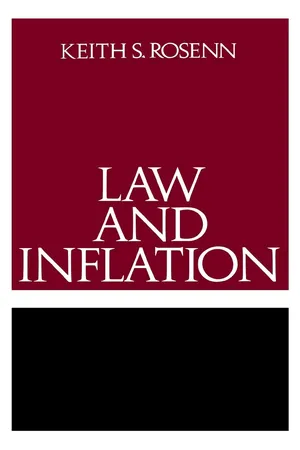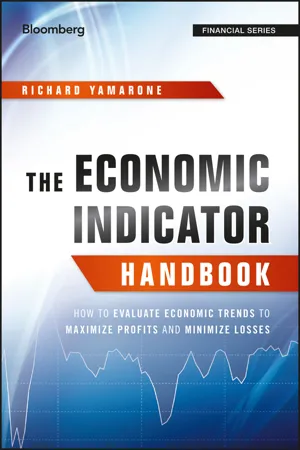Economics
Measures of Inflation
Measures of inflation refer to the various methods used to track and quantify changes in the general price level of goods and services in an economy over time. Common measures include the Consumer Price Index (CPI), Producer Price Index (PPI), and the GDP deflator. These measures provide valuable insights into the rate of inflation and its impact on purchasing power and economic stability.
Written by Perlego with AI-assistance
Related key terms
1 of 5
12 Key excerpts on "Measures of Inflation"
- eBook - ePub
Trading Economics
A Guide to Economic Statistics for Practitioners and Students
- Trevor Williams, Victoria Turton(Authors)
- 2014(Publication Date)
- Wiley(Publisher)
Lower earnings growth has been recorded across many sectors. The consequences for this are reductions in disposable income, expenditure and economic growth. Earnings inflation is also relevant as a labour cost for businesses. It has an impact on firms' profitability and thus on the equity and bond markets.PRICE BASKET
Price changes, inflation or deflation, are measured from a basket of goods and services that are based on what is typically bought by the average consumer, either household or business. An index is created that is based on a summary of the total price changes in this basket of goods and services. The change in this index is then taken as the inflation or the deflation rate, depending on whether it is going up or down. This is based on an estimate of the index over time (see Appendix 3 for more detail).HOW IS PRICE INFLATION MEASURED?
At the last count there were about 12 different measures of consumer price inflation in the UK. In addition to publishing the Consumer Price Indices (CPI) in the UK on a monthly basis, the Office for National Statistics (ONS) publishes a number of other indices, including:- CPIH – Consumer Price Indices Including Housing Costs
- RPI – Retail Price Indices
- PPI – Producer Prices Indices
- HPI – House Price Index
- SPPIs – Service Producer Price Indices.
Typically, they are measured on a monthly basis, but they can also be measured quarterly or annually. The changes can therefore be calculated month-on-month, same month on the year before or on the previous quarter. In actual fact, the one most frequently quoted in the media and watched by most commentators is the annual or 12-month change.And if you have ever thought you were paying more for your loaf of bread this year than last, you can measure the inflationary impact for yourself. Inflationary forces and their measure are so intrinsic to our lives, that you can go to the ONS website to create your very own CPI measure, based on your weekly or monthly shopping basket (see http://ons.gov.uk/ons/interactive/index.html - eBook - PDF
Trading Economics
A Guide to Economic Statistics for Practitioners and Students
- Trevor Williams, Victoria Turton(Authors)
- 2014(Publication Date)
- Wiley(Publisher)
4 Lower earnings growth has been recorded across many sectors. The consequences for this are reductions in disposable income, expenditure and economic growth. Earnings inflation is also relevant as a labour cost for businesses. It has an impact on firms’ profitability and thus on the equity and bond markets. 4 Labour Market Statistics, April 2013, released 17 April 2013, Office for National Statistics. 110 Trading Economics PRICE BASKET Price changes, inflation or deflation, are measured from a basket of goods and services that are based on what is typically bought by the average consumer, either household or business. An index is created that is based on a summary of the total price changes in this basket of goods and services. The change in this index is then taken as the inflation or the deflation rate, depending on whether it is going up or down. This is based on an estimate of the index over time (see Appendix 3 for more detail). HOW IS PRICE INFLATION MEASURED? At the last count there were about 12 different measures of consumer price inflation in the UK. In addition to publishing the Consumer Price Indices (CPI) in the UK on a monthly basis, the Office for National Statistics (ONS) publishes a number of other indices, including: ∙ CPIH – Consumer Price Indices Including Housing Costs ∙ RPI – Retail Price Indices ∙ PPI – Producer Prices Indices ∙ HPI – House Price Index ∙ SPPIs – Service Producer Price Indices. These measure prices charged by companies for their goods and the prices they pay for their inputs. Typically, they are measured on a monthly basis, but they can also be measured quarterly or annually. The changes can therefore be calculated month-on-month, same month on the year before or on the previous quarter. In actual fact, the one most frequently quoted in the media and watched by most commentators is the annual or 12-month change. - eBook - PDF
- Manzur Rashid, Peter Antonioni(Authors)
- 2015(Publication Date)
- For Dummies(Publisher)
Assessing different measures Economists use different ways of calculating inflation. In the earlier section ‘Compiling a basket of products and services’, we describe how the main measure of inflation in the UK, the CPI, is calculated. Luckily, the other mea-sures are calculated in a similar way, though some important differences apply too. 70 Part II: Measuring the Things that Matter Having more than one inflation measure raises an important question: which one is right? The truth is that economists don’t think that one is ‘right’ and the others are ‘wrong’. Instead, the different measures use different method-ologies, and one is more appropriate in one situation and another in a differ-ent situation. Here are the three most commonly used measures and some key information about each one. CPI As its name suggests, the Consumer Price Index (CPI) is an index. Therefore, the value of the CPI at any point in time on its own isn’t very helpful. What really matters is the percentage change in the index over time: from one year to another or one month to the next. The base year for the CPI is 2005, which means that its value was set to 100 in 2005. Statisticians chose this year arbitrarily; they could’ve picked any other year without impacting on the rate of inflation from one year to the next. The base year just provides a useful benchmark: for example, if the current CPI value is 130, prices are now on average 30 per cent higher than in 2005. The CPI purposefully excludes a large component of many households’ expenditure: mortgage interest payments. To understand why, read Chapter 10 on monetary policy. But for this discussion, just bear in mind that if policy makers want to reduce inflation, the key tool at their disposal is to increase the interest rate in the economy. For a number of reasons, this causes the prices of goods and services to fall (or increase by less). But, of course, it also means higher mortgage interest payments. - eBook - ePub
What Drives Prices in Egypt?
An Analysis in Light of International Experience
- Hanaa Kheir-El-Din(Author)
- 2009(Publication Date)
- The American University in Cairo Press(Publisher)
The methodological framework of this study presents an array of the most commonly used price indices in order to identify the most appropriate measure for the analysis of inflation. The study then discusses the construction of the CPI in Egypt, and reviews and updates the assessment of the quality of Egypt’s CPI against the internationally accepted guidelines and practices. The remainder of the study is organized as follows. The first section reviews the different approaches used for inflation measures, highlighting their strengths and weaknesses. The second section describes the construction of the CPI in Egypt (its scope, data collection and processing, calculation methods, etc.), and presents recent developments undertaken to improve its accuracy. The third section reviews previous work assessing the quality of Egypt’s CPI and updates this assessment against international standards and practices taking into consideration recent improvements by CAMPAS. The fourth section summarizes the overall findings of the study and suggests a number of proposals to improve Egypt’s CPI accuracy.Inflation MeasurementAccording to Webster’s dictionary, inflation is often said to be “persistent increases in the general level of prices, or a persistent decline in the purchasing power of money, caused by an increase in available currency and credit beyond available quantities of goods and services.” The first part of the definition refers to general conditions while the latter part refers mostly to monetary aspects of rising prices (Guðnason 2003). However, both parts imply that only sustained increases in prices or sustained declines in the purchasing power of money are considered as inflation. Thus, any temporary increase in prices or temporary decline in the purchasing power of money should be excluded from the inflation measure. Furthermore, inflation is an increase in the general level of prices, which means that an increase in one price, others remaining the same, is a change in relative prices and is not considered as inflation per se (Wahl 1983).The question then arises of how to measure this permanent increase (or more precisely, change) in prices. The answer is certainly: by using price indices that measure price changes in distinct periods. There is some convergence of views as to the ideal conceptual properties that would be possessed by a system of price indices designed for the analysis of inflation. These can be summarized as follows (ABS 1997): - eBook - ePub
The History of the Bundesbank
Lessons for the European Central Bank
- Jakob De Haan(Author)
- 2012(Publication Date)
- Taylor & Francis(Publisher)
Measurement issues in the consumer price index are discussed in Section 4.2. Section 4.3 presents empirical evidence on the sacrifice ratio of disinflation policies. Section 4.4 turns to the benefits of price stability: we estimate the effects of inflation on consumption allocation, housing demand, money demand and government debt service. For a permanent reduction of inflation by 2 percentage points (from 2 per cent to zero), we find that the benefits of price stability exceed the costs of disinflation by more than 1 per cent of the GDP. Section 4.5 presents our conclusions. 4.2 Measurement of inflation Targeting a well-defined stock of money in a medium-term oriented framework has been the key to the strategy of the Deutsche Bundesbank. Such a policy draws on the long-run relationship between money and prices. What we really mean by the notion of a general price level depends on the preferred basket of goods (and services), the way we measure individual prices and the formulas that we use to aggregate prices to an overall price index. From the quantity theory point of view, an index for the measurement of inflation for the purposes of monetary policy should be broadly based, and should include the prices of both consumption and investment goods. This suggests the use of the GDP deflator or the domestic demand deflator to measure inflation. In contrast, the consumer price index (CPI) measures the price changes of goods that are used for consumption purposes. This index captures only part of domestic price movements. However, it is quickly available and easy to interpret, it receives most attention from the public and serves as the key indicator of changes in the purchasing power of money in wage negotiations - eBook - PDF
- Keith S. Rosenn(Author)
- 2015(Publication Date)
- University of Pennsylvania Press(Publisher)
2 THE MEASUREMENT OF INFLATION If a legal system is to take inflation into account, the law has to rely on some device to measure inflation. Most legal systems presently assign monetary values to rights and responsibilities. If one is to disregard the fiction that a currency unit is always equal to itself, the law has to find some way of quantifying the adjustments it will have to make to its normal measuring stick, the currency unit. The point is not that the law cannot take account of concepts which cannot be easily measured. Lawyers deal daily with concepts like negligence, pain and suffering, and intent, none of which is easily measurable. THE PRICE INDEXES There is no way to know precisely how much inflation any economy is undergoing. There are billions of prices in modern economies, and there is no feasible method to monitor their constant movements. The best approximations are price indexes. The three most commonly used of these yardsticks are (1) the consumer price index (sometimes referred to as the cost-of-living index or the retail price index); (2) the wholesale price index; and (3) the implicit GNP deflator. What are these indexes? How are they constructed? How accurate are they? What universe do they measure? Without a basic understanding of these indexes' derivation, lawyers cannot assess the degree to which their clients are protected from economic loss due to inflation, nor can judges or legislators intelligently appraise the costs and benefits of any inflation adjustment schemes. The next three sections provide a thumbnail sketch of what the three most common infla-tion indexes actually measure, a brief evaluation of their strengths and weaknesses, and a guide to construction of a price index. The Consumer Price Index Consumer price indexes attempt to measure changes over time in the prices of equivalent goods and services that are consumed during the 21 2 2 L A W A N D I N F L A T I O N normal course of living. - eBook - ePub
- Norman Frumkin(Author)
- 2015(Publication Date)
- Routledge(Publisher)
Prices of goods and services vary considerably among individual items bought and sold in the marketplace. There is the intrinsic difference in the absolute price of one item in comparison to another at a point in time, such as the price of a car and of college tuition. There are continuing differences in the movements of prices over time, such as price changes of a car and of college tuition from one year to the next. Some items rise in price more than others, some decline in price more than others, and some are unchanged from one period to the next. These differential price movements reflect actual or perceived shortages or surpluses among buyers and sellers and varying degrees of price competition for particular items. Changes in overall price levels for the total of all goods and services are the net effect of the varying upward, downward, and stable movements of the vast number of items sold in markets around the United States.There are also varying degrees of inflation (price increases) and deflation (price decreases) that have differential effects on the economy. In general, overall price movements affect the economic well-being of the population in the following way: people are better off if their incomes increase more than prices increase, or if their incomes fall less than prices fall.There are sometimes sharp differences between the price movements of goods and services produced on a current basis and the price movements in the sales of real property and financial assets that are a measure of wealth. Real property asset values of housing prices and financial asset values of common stock prices became prominent in the late 1990s and early 2000s for their effect on the purchasing power of households in spending on goods, services, and new and existing housing. This is referred to as the “wealth effect.”This chapter focuses on the consumer price index (CPI) as the prime measure of inflation and deflation in the economy. The CPI is the most widely cited measure of price change, and most government programs such as Social Security and business and labor contracts with price escalation formulas are linked to the CPI. Over time, the CPI implicitly incorporates price movements of the producer price indexes that gauge the price movements of all U.S. produced goods, and the price indexes associated with the gross domestic product (GDP) that encompass price movements of the household, business, government, and international sectors of the economy (chapter 3 , “Economic Growth,” covers the GDP). The CPI measures prices of items bought by households as representative of the price movements over time associated with the production of all goods and services. The chapter also includes a discussion of the inflationary and deflationary implications of the price movements of common stock and housing assets - eBook - ePub
- P Mohr, D Yu, S Adendorff(Authors)
- 2020(Publication Date)
- Van Schaik Publishers(Publisher)
996Inflation
Since World War II most countries have experienced sustained, frequently rapid, price increases and as a result there is great interest in the inflation phenomenon in general and in inflation data in particular. Many other economic variables (eg wages, salaries, interest rates and rent) are either directly or indirectly linked to price increases and it is therefore important to measure inflation as accurately as possible. With the adoption of inflation targeting by the South African government in 2000 the measurement of inflation assumed even greater importance.To measure inflation, which is defined as a sustained increase in the general price level, a yardstick of the general price level and an appropriate period for measuring changes in this yardstick have to be selected. Various price indices therefore have to be examined. But before this can be done, the more general topic of index numbers has to be investigated.In this chapter we start with a brief explanation of index numbers, followed by discussions of price indices in general and various specific price indices. It is also explained how these indices can be used to calculate inflation rates, which are by definition rates of change. Some examples are provided, and the advantages and disadvantages of different price indices and different measurement periods are discussed. In the process, some of the most common errors in calculating and interpreting inflation rates are also pointed out.6.1 INDEX NUMBERS
As mentioned above, inflation is defined as a sustained increase in the general price level. The general price level, however, is not directly observable. The quantities of goods and services are expressed in a variety of physical units (eg tonne, kilogram, 100 litre, metre, watt, carat) and their prices are often not directly comparable. Some way therefore has to be found to combine the prices of a wide variety of goods and services into a single number. The solution is to use index numbers and to construct a price index. The topic of index numbers is wide-ranging and in this section we confine ourselves to those aspects that are required for an understanding of the compilation and interpretation of general or composite price indices.1 - eBook - ePub
The Economic Indicator Handbook
How to Evaluate Economic Trends to Maximize Profits and Minimize Losses
- Richard Yamarone(Author)
- 2016(Publication Date)
- Bloomberg Press(Publisher)
In recent years, economists have fretted about the possibility of deflation in the United States. Growing globalization has sent production facilities to low-wage nations such as China and India, which send incredibly low-priced footwear, toys, textiles, telecommunication devices, and foods back to the United States. Prices of nonimported services, such as tuition, medical care, and electricity, however, continue to rise. So, although certain industries have experienced deflation, the economy as a whole has not. In a true deflationary spiral, all prices decline at all levels, wholesale and retail.The Consumer Price Index
The Consumer Price Index (CPI) is the most popular measure of inflation on the retail level. It represents prices on the demand side of the economy. To gather the data used to construct the index, field economists from the BLS visit supermarkets, department stores, gasoline stations, hospitals, and other establishments in 87 urban areas all around the nation, recording prices of food, fuel, beverages, apparel, health care, and other goods and services.The Consumer Price Index tracks the change in price, at the consumer level, of a weighted basket of 211 goods and services categories in 38 geographic areas for a total of 8,018 item-areas combinations. The composition of this basket reflects households' typical monthly purchases, as revealed in the Consumer Expenditure Survey, which the Census Bureau conducts for the Bureau of Labor Statistics. The weight given each item is determined by its percentage of total household expenditures.The Consumer Price Index has two basic versions: the CPI-U, which reflects the buying habits of all urban consumers, and the older CPI-W, which relates only to urban households that include a wage earner or clerical worker. The two versions employ data from the same survey and are constructed using the same methodology. They differ only in the weight given certain basket components.Wall Street and the media focus on the CPI-U, because it represents roughly 87 percent of the noninstitutionalized population, compared with the CPI-W's lowly 32 percent. National and local governments, businesses, and organizations employ the CPI-U in forming and implementing policies. Economists use it to adjust nominal-dollar-based indicators, such as retail sales, for inflation. All of the discussions of the Consumer Price Index in this book refer to the CPI-U. - eBook - ePub
The Trader's Guide to the Euro Area
Economic Indicators, the ECB and the Euro Crisis
- David J. Powell(Author)
- 2013(Publication Date)
- Bloomberg Press(Publisher)
Chapter 5
Inflation Measures
The ECB – and most central banks – aims to achieve price stability. This includes avoiding a continuous rise or decline of the general price level. The former is referred to as inflation and the latter as deflation. Disinflation refers to a deceleration in the rate of price increases. Economists generally believe that price stability contributes to increasing the level of economic output and employment in the medium to long term.Economists break down inflation into two different types. The categories are referred to as cost push and demand pull. The former refers to a rise in prices that is caused by an increase in input costs such as commodities and wages. The latter refers to a rise in prices caused by demand outstripping supply.Consumer Price Index
The most closely watched indicator of inflation for the euro area and most countries around the world is the CPI. The measure for the euro area is specifically called the harmonized index of consumer prices (HICP).The data are released in two parts. Eurostat publishes a flash estimate on the last working day of the reference period. It is calculated by using energy prices, early HICP data from those member states that publish their own flash estimates (Germany, Italy, Spain and Slovenia) and “early estimates provided by some member states to Eurostat on a confidential basis.”1 The core measure, which excludes energy, food, alcohol and tobacco, is included with this release.The readings from the individual countries are omitted from this announcement. The full report is published about 15 days after the end of the reporting month and provides a breakdown by category and figures for each country of the monetary union.Eurostat makes no seasonal adjustments of the HICP time series. The month-over-month readings may therefore be influenced by holidays and the weather. For example, clothing prices may decline every year in January as retailers attempt to clear unsold inventories from the Christmas shopping period and fresh fruits may be more expensive in winter, when they are out of season, than in summer. Market participants focus on the year-over-year measure because it provides the underlying trend, though it may be distorted by base effects. The data series begins with figures from 1996, though they have been rebased to 2005. - Mark Mobius(Author)
- 2020(Publication Date)
- Wiley(Publisher)
6 Measuring InflationAs there are wide disagreements among economists as to inflation's root cause, it is perhaps not surprising that the inflation figures themselves are also a source of argument. Although the CPI – the Consumer Price Index – is the most commonly used measure, there exists an alphabet soup of inflation indicators in addition to the CPI such as the Personal Consumption Expenditures Price Index (PCEPI), the Employment Cost Index (ECI), the Producer Price Index (PPI), the Harmonized Index for Consumer Prices (HICP), and others.Why You Can't Trust the Inflation Numbers
In a January 2011 Wall Street Journal online article by Brett Arends, the headline read: “Why You Can't Trust the Inflation Numbers.” Arends said people on Wall Street did not worry about inflation since in the previous 12 months the CPI had risen by only 1.5% – a very low rate. And if the volatile food and energy costs were stripped out, then the rate was a meager 0.8%. Many economists were pointing out that wages were rising by less than 2% a year. With so many people still out of work, went the line, labor costs were going to stay low for a long time too. Investors holding inflation‐protected bonds which had fallen in price with the low inflation rate were losing. He said that ten‐year Treasury bonds yielded less than they did when President Eisenhower left office. But he warned there was a lot to worry about because the inflation numbers could not be trusted. Over the previous 30 years, the federal government under every government of both Republican and Democratic parties had made changes in the way inflation was calculated and the changes tended to flatten the inflation rate.Arends pointed to findings by John Williams at Shadow Government Statistics who had said that if inflation was still calculated with the same set of items, the inflation numbers came out lower because of replacement. If the price of steak rose, the government assumed consumers purchased cheaper hamburger, so they replaced steak with hamburger. It thus looked like the price went down. The price of a Mac computer was reduced because of technical improvements using “hedonics.” Hedonics is an effort to adjust inflation to take account for product quality changes. So a product may have increased in price, but the price increase was due to improved quality and not inflation. If a computer increased in price by 10% and the computer was exactly the same, then it would reflect an inflation of 10%; but if the speed and efficiency of the computer was improved by the manufacturer, the price increase could not be considered inflationary since, in essence, the actual product has changed and a comparison was not possible.- eBook - PDF
- Magnus Blomstrom, Jennifer Corbett, Fumio Hayashi, Anil Kashyap, Magnus Blomstrom, Jennifer Corbett, Fumio Hayashi, Anil Kashyap(Authors)
- 2007(Publication Date)
- University of Chicago Press(Publisher)
The weights are revised every five years, incorporating the latest FIES. Especially since the late 1990s when deflationary pressure became ap-parent, the CPI index has been criticized for its apparent failure to register the impact of rapidly declining retail prices as reported in the media and by some of the largest national general merchandise stores (GMSs). 5 Compared to the CPI in the United States, there are several notable di ff erences in data-collection procedures and lower-level aggregations. The Japanese CPI includes a larger number of individual items (roughly 600 compared to about 200 in the United States). For each item, Japan uses a single brand and a single retail outlet within each designated area to sur-vey prices. Both the outlets and items used are rotated in the United States. Surveys are prices on specific days of each month rather than averages over period or brands, as in the United States. Arithmetic means are used in every stage of aggregation, rather than geometric means. (The United States converted to geometric for lower-level aggregation in January 1999, as recommended by the 1996 Boskin Commission Report.) 4.3.1 Alternative Inflation Measures If the CPI inflation rate is so problematic, why not use some other mea-sures such as the GDP deflator or WPI? In fact, all of these are used to mea-sure inflation, and many view the GDP deflator as a better indicator than the CPI. However, the same primary price survey data are used to estimate Mismeasurement of the CPI 97 5. The most comprehensive study is Shiratsuka (1997). Shiratsuka (1999) o ff ers a review of his 1997 monograph and other major studies in English. So ¯musho posts various documents prepared by the Ministry on this issue at http://www.stat.go.jp/data/cpi/8.html. GDP deflators as to estimate CPI and WPI. So, if CPI and WPI data con-tain measurement errors, they will also appear in other processed statistics such as the GDP deflator.
Index pages curate the most relevant extracts from our library of academic textbooks. They’ve been created using an in-house natural language model (NLM), each adding context and meaning to key research topics.











